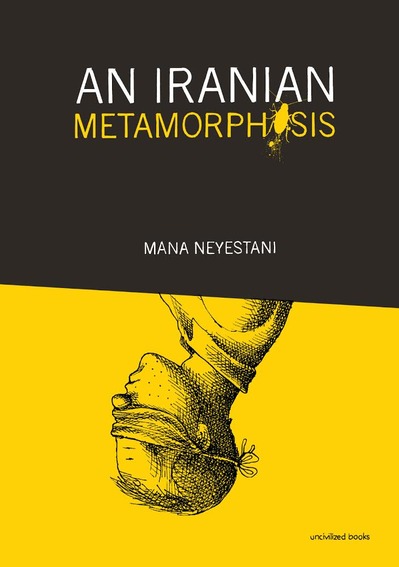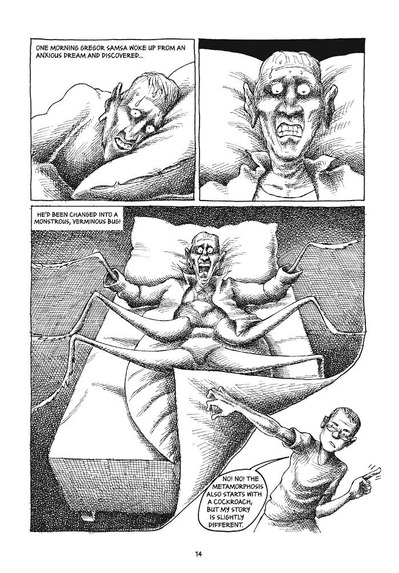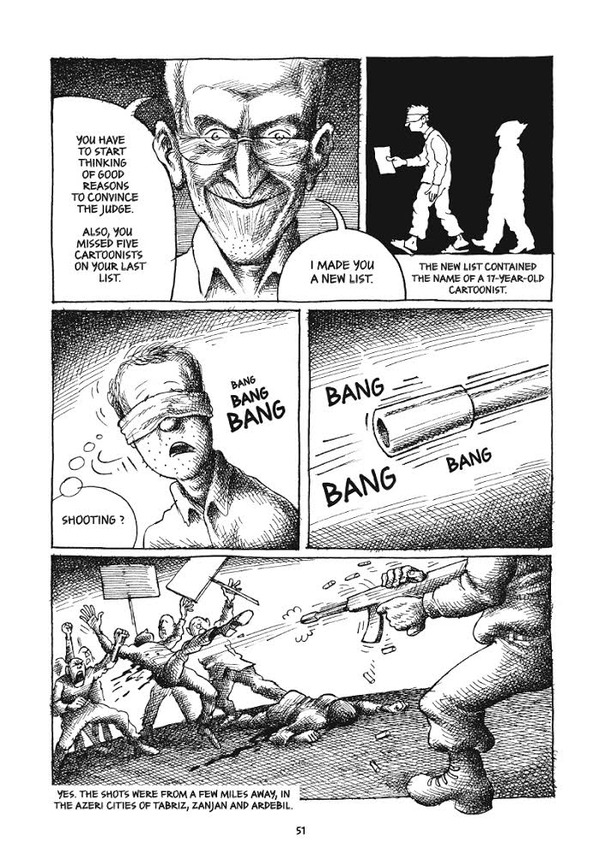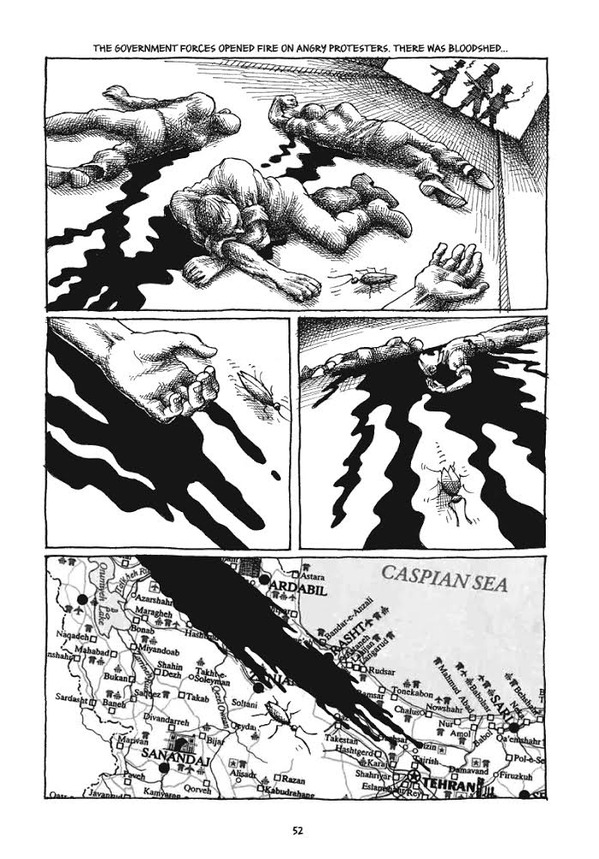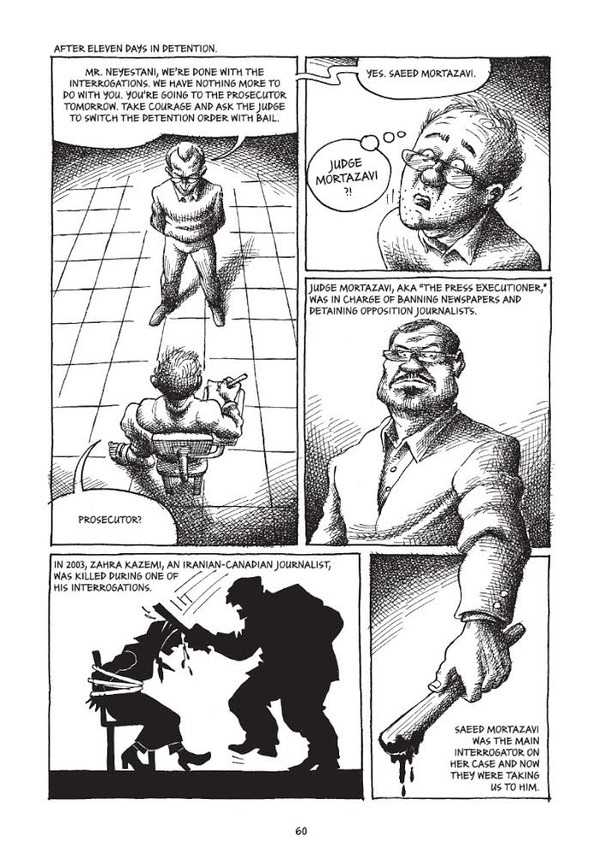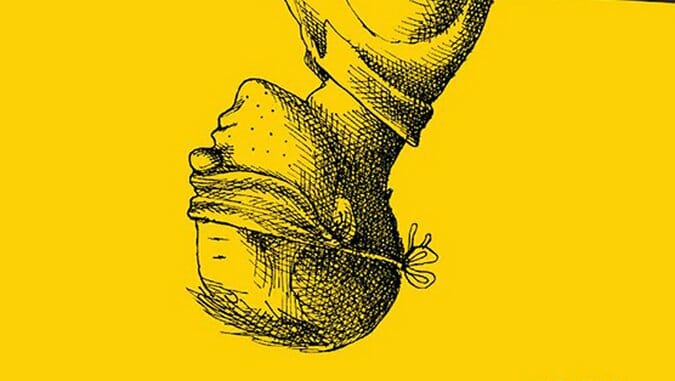
It begins with a blank space, and an urgent call to fill it. That could be taken as a metaphor for any writer or artist, but in Mana Neyestani’s graphic novel, An Iranian Metamorphosis, it’s also a nerve-wrackingly literal statement. As this memoir opens, Neyestani finds himself in Turkey, seeking refuge after something — the actual event remains purposely ambiguous — has caused him to leave his home in Iran. He’s been traumatized by the experience; even as he waits in an office for refugees and attempts to summarize the events that have brought him there, he chafes under the growing anxiety that he may have exchanged one nightmarish bureaucracy for another. And, sure enough, the official shouting at him to “stay inside the frame” resurfaces throughout the narrative; the shape and layout of panels even echo the impositions and regulations that held Neyestani in place and imprisoned him in his home country.
So, yes, An Iranian Metamorphosis is quite literally a Kafka-esque situation — hence the book’s title, as well as a recurring motif of a cockroach that haunts Neyestani in detention cells, hotel rooms and airplanes. “I know the book is more The Trial than Metamorphosis, but I like the idea of ‘changing or losing the identity,’ and I found it similar to my situation,” Neyestani wrote via email from his home in France. “You wake up some day and see that you are not the person you knew anymore. You were a respectful artist before, now you are a convict. They call you racist, a menace for the society.”
As Neyestani describes in his book, he began his career drawing political cartoons, but shifted to illustrating comics for children over time. (Sohelil, a character Neyestani used in his comics for kids, periodically surfaces in An Iranian Metamorphosis to bedevil Neyestani — first in a comic invocation of writer’s block, and later under more perilous circumstances). In 2005, the newspaper he worked for, Iran, fell under more strictly-religious ownership. In 2006, Neyestani drew a strip in which the word choice of a cockroach was taken by some as having racist connotations against the Azerbaijani, a Turkish-speaking group in Iran. Existing tensions in Iranian society strained further, and protests broke out. The outcome caused Neyestani and his editor, Mehrdad Ghasemfar, to face detainment, forced into a legal and logistical nightmare: a detention of indefinite length. Later, one of the Azeri protestors briefly shared Neyestani’s cell; their interaction in the book puts the protests into a broader societal context.
For Neyestani, revisiting the work he did prior to being detailed is still difficult. “It was so ordinary and never meant to make such troubles,” he said. “I was an editorial cartoonist, and it’s not strange to face the consequences of your work, but as a cartoonist you prefer to be punished for the real meaning of your work, not misinterpretations.”
The methods Neyestani chooses to tell his story reflects his background of both cartoons and editorial work. His approach in Metamorphosis blends styles, sometimes within the same panel. He’s perfectly at home drawing characters in a realistically: along with his wife Monsoureh and his editor, Neyestani’s illustrations of himself are expressive and simple, a basic everyman amidst the distorted nightmares. Other characters are drawn in an exaggerated manner that evokes the toothy, grotesque detail of iconic horror artist Richard Corben; at times, more cartoonish characters also enter the mix.
Though nonfiction, Neyestani’s work often takes on expressionism elements: the cell where he’s detained transforms into an entirely different space — a raft adrift on the waves, for example — or the way a photograph of his wife causes repressed desire to surface via romantic fantasies during his time in detainment. What Neyestani pursues is less a straightforward account of his time detained, but a glimpse inside how that time affected him, both in terms of the fear and the sense of paranoia he felt. Even his temporary spells of freedom cause a new, different kind of anxiety. The way the panels of the comic reflect the cell’s grid motif exacerbate these visceral qualities even more.
A fictionalized version of a Chinese border guard Neyestani and Monsoureh encounter later in the book also functions as a key device of expressionism. “I think it was in the middle of the book that I decided to make the Chinese character,” Neyestani recalls. “I thought, it is interesting to make a character who experienced a life in dictatorship in another country so far from Iran, and suddenly the destiny put us in front of each other, like a duel!”
Neyestani and Monsoureh’s search for refuge leads them into Turkey; from there, they enter a world of shifting borders, false passports, and sweat-soaked moments at international checkpoints. The graphic novel ends with this process still in progress; a textual epilogue completes the story. “I am working on a comic manual for the asylum seekers who wants to get refugee status in France,” Neyestani said, when asked about his future projects. But there are also plans for other explorations of society and violence: “Also I am working with a friend on another script for a graphic novel about a ‘religious serial killer’ in Iran who killed 16-17 prostitutes.”
An Iranian Metamorphosis is, ultimately, many things: an exploration of a number of storytelling devices, a portrait of a marriage under siege from external forces, and one man’s harrowing education of the horrific underside within his society. In the end, it’s a dizzying read, but also a deeply moving one — and a work whose surreality and exploration form an eminently fitting component of Kafka’s legacy.
